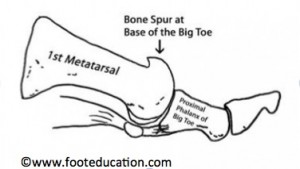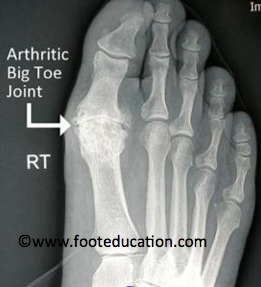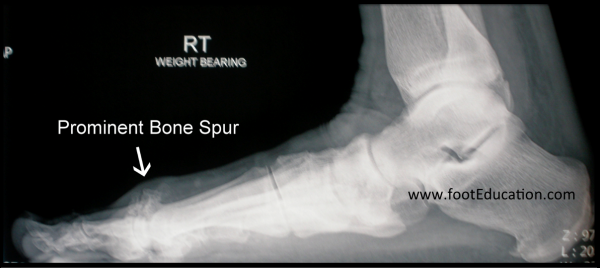Hallux Rigidus
(aka Hallux Limitus or Big Toe Arthritis)
Summary
Watch Video: Hallux Rigidus, Big Toe Arthritis
Printable Patient Handout: Great Toe Arthritis
Hallux rigidus is essentially a progressive arthritis, leading to stiffness and pain in the big toe joints (Figure 1A -1st MTP joint). The loss of joint cartilage, which occurs first along the top half of this joint, is believed to result from changes in joint dynamics that lead to increased pressure across the joint as the toe bends upward. This can take many years to develop, but can become quite symptomatic. In the later stages of this disease process, cartilage covering the remainder of the joint surface also erodes, leading to a progressively worse and more bothersome arthritic joint. There are very good treatment options, both conservative and surgical, to alleviate persistent symptoms in patients with hallux patients with hallux rigidus.
Figure 1A: Hallux Rigidus Pain Location

Figure 1B: Great Toe Joint Bone Spur

Clinical Presentation
Patients with hallux rigidus will typically present with pain, stiffness, and swelling in the great toe joint. This is aggravated by activities that involve excessive, repetitive upward movement of the big toe joint, such as prolonged walking, running, and walking up hills. Swelling usually occurs along the top half of the joint, and will be frequently associated with bone spur formation, recognized as a “new prominence” by the patient (See Figure 1B). As the condition progresses, patients often compensate by putting more weight on the outside of the foot as they walk. This may cause pain in other parts of the forefoot (metatarsalgia). Physical examination will reveal limited and often painful motion in the big toe joint, particularly when the patient is weight-bearing. Prominent bone spurs [osteophytes] on the top part of the joint are usually visible, palpable, and tender. It is very common to see these findings in both feet, although usually one foot is more symptomatic than the other. Tenderness to touch is common over the swollen great toe joint. Pain is generally worse with activities and is alleviated by resting from activities and use of stiff shoes.
Imaging Studies
Weight-bearing foot x-rays will typically identify some loss of first MTP joint cartilage, seen as narrowing of this space on the x-ray – as compared to other similar spaces seen in nearby unaffected joints. There may be squaring of the metatarsal head on the anterioposterior view. The lateral view will often show a prominent dorsal bone spur (See Figure 2).
Figure 2A and 2B: Weight-bearing x-rays showing Hallux Rigidus


Treatment
Non-Operative Treatment
In most cases, hallux rigidus can be successfully treated non-operatively. The principle of nonoperative treatment is to decrease the inflammation in the arthritic joint by limiting the overall arc of motion through this joint. Successful non-operative management often involves:
- Limiting great toe motion. The pain associated with movement of this joint can be limited with the use of a stiff-soled shoe, with a slight rocker bottom contour. Alternatively, a rigid shank can be applied to the shoe, a foot plate may be inserted under the orthotic, or an orthotic with a Morton’s extension or a “Turf Toe Plate” can be used. Each of these serve to decrease or eliminate the painful motion of this great toe joint with walking or running, when affected by hallux rigidus.
- Comfort shoes with a wide-toe box made of soft material should be used to allow more space for the great toe thereby limiting the irritation over the swollen toe.
- Anti-inflammatory medication. The use of an over the counter anti-inflammatory may also be helpful in improving symptoms. This includes oral anti-inflammatory medications and topical anti-inflammatory medications, which should be used only as directed.
- Injection. Short-term improvement of symptoms may alternatively be obtained with injection of a corticosteroid or hyaluronic acid, derivative into the first MTP joint. Unfortunately, these treatments will not lead to predictable, long-term improvement in the patient’s symptoms, and therefore have limited indications. They can, however, provide significant short-term relief – although they are not recommended for repetitive, long-term use, even if effective because of potentially cumulative side effects.
Operative Treatment
When patients fail non-operative management, reasonable operative options are available and should be considered. There are three broad categories of operative treatment. These include:
- 1st MTP joint dorsal cheilectomy (Bone spur removal).
- Fusion of the first MTP joint.
- First MTP joint arthroplasty (first MTP joint replacement).
Click Here for a Summary Handout on Hallux Rigidus
Edited on April 21st, 2025
Previously Edited by Ken Hunt MD and Michael Castro, DO